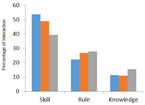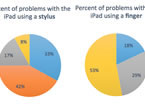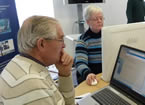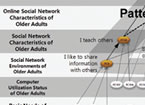Articles about Adultos mayores
(English) The Importance of Designing for the Elderly in a Post-COVID World

(English) One major impact of COVID-19 has been the rapidly rising number of older adults using the internet to work, shop, engage in social activities, and stay connected to family and friends. Many in this demographic, while they have real-world knowledge and experiences, may have challenges using online technologies and mobile devices. Hossein Raspberry provides insights on demystifying inclusive design and driving accessibility design in technology. [Leer más]
Activismo y COVID-19: las mujeres mayores del Sudeste Asiático adoptan la tecnología

(English) A study describing how older women in Southeast Asia have used technology to spread positivity and creativity during COVID-19. [Leer más]
Banca en línea para todos: diseñar para personas mayores

Realizar un diseño para personas mayores o con poca experiencia en informática requiere que se definan estrictamente las funcionalidades del sitio web, flujos de trabajo claros y mínimas distracciones en la página. [Leer más]
Diseñar para usuarios vulnerables: Ilustraciones que (pueden) ayudar a entender sitios web complejos sobre salud

Las ilustraciones tienen el potencial de ayudar a entender información compleja sobre salud, pero usar las imágenes de manera efectiva requiere ajustarlas a las necesidades de un rango amplio de usuarios. [Leer más]
Probando la Tecnología del Futuro: Experiencia de Usuario para una Población que Envejece

Un análisis de investigaciones actuales fue usado para crear un marco de referencia para hacer análisis de mercado y de competidores al pensar sobre las necesidades de adultos mayores en el diseño de tecnologías asistidas. [Leer más]
Atención médica en línea: Diseño de una privacidad fácil de usar para personas mayores

Crear una experiencia de servicio en línea para personas mayores en Philips Home Monitoring incluía desafíos en privacidad, experiencia de usuario, limitaciones de sistemas preexistentes y comunicación. [Leer más]
Votar desde un iPad: Desafíos para personas mayores

¿Pueden las personas mayores usar iPads para tareas críticas como votar? Los residentes en centros de cuidado a largo plazo están dispuestos a intentarlo, pero tienen problemas con la interacción táctil. [Leer más]
(English) Never Too Old: Incorporating Digital Technologies into the Lives of Older Persons

(English) We need to learn how older people use technology to determine when and how to implement accessibility features rather than always seeking a “special” solution. [Leer más]
(English) Social Network Sites for Older Adults: Online User Experience for Korean Seniors

(English) Designing social networking systems which meet the needs of current seniors will enable them to use these systems to improve their quality of life. [Leer más]
(English) What Do We Know about Older Users? How Old is Old?

(English) Usability professionals have many of the same preconceptions about aging and technology use as those exhibited by people in other professions. [Leer más]
(English) The Aging Brain: At the Crossroads of Attention and Memory

(English) Although slowed with aging, difficulties in suppressing irrelevant information, affecting attention span and memory retention, are found in all age groups. [Leer más]
(English) Design for the Aging Brain (Commentary of Dr. Gazzaley’s The Aging Brain)

(English) We need to understand the mechanisms that underlie the physical and mental changes of aging to design products that interface well with older adults' cognitive abilities. [Leer más]
(English) Conducting Field Studies with Older Adults Lessons for Recruiting and Testing Older Users

(English) Field testing and field research work especially well with older adults, if you are sensitive to their needs in both the recruiting and data collection process. [Leer más]
(English) Designing Spaces for Dementia: An Interview with Terry Carson

(English) An interview with Terry Carson, the owner of residential facilities for people with dementia and Alzheimer's disease. [Leer más]
(English) Geographic Orientation & Disorientation: Getting Lost and Getting Found in Real and Information Spaces
(English) To reduce problems of navigational disorientation, incorporate different sets of orientation factors and accommodate the needs and abilities of all users. [Leer más]
(English) Web 2.0 for an Older Population: Exploring the Limits

(English) To enable a rapidly aging population with the connected social experiences that younger Web users experience, find balance between replacing and augmenting offline activity. [Leer más]
(English) Older Users Online: WAI Guidelines Address the Web Experiences of Older Users
(English) A review of research into overlaps between the accessibility needs of older users and people with disabilities showed that WCAG 2.0 meets most of the identified requirements of older web users. The article introduces the WAI-AGE project. [Leer más]
(English) The View from Here: When is Enough Enough?
(English) As we age, we are constantly compromising, and redefining what we view as living. [Leer más]
(English) What’s News: Helping Seniors Helps Everybody
(English) With the aging of the baby boomers, product developers are realizing that there’s money to be made by making products more user-friendly to older people. [Leer más]
(English) Book Review: Assisted Loving

(English) The book is a consciousness-raiser for family members who are dealing with aging seniors as they enter new phases of their lives. [Leer más]
(English) Editor’s Note: Platinum Perspectives on Usability and User Experience
(English) The role of seniors have important implications for the policies and focus of attention for our professional organizations and daily life. [Leer más]

